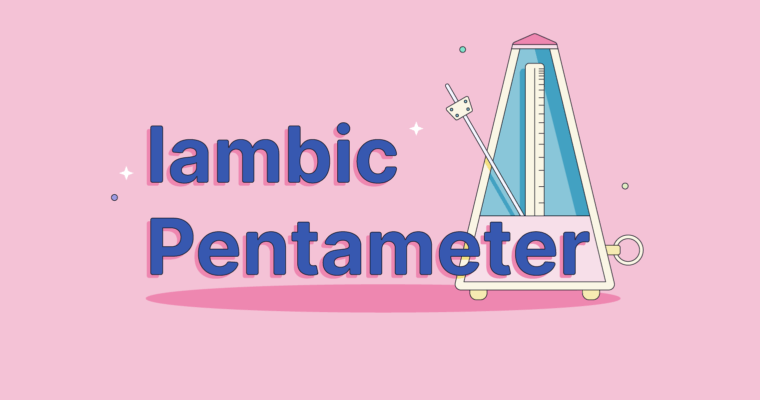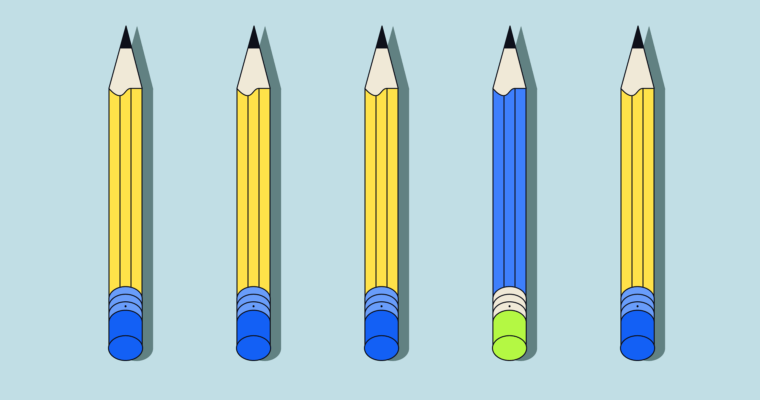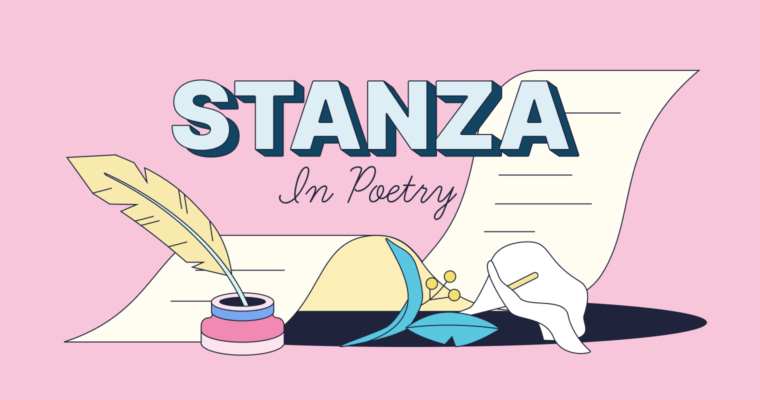
You’ve probably heard of William Shakespeare, that olde English fellow, the famed poet often referred to as the father of our modern language. While reading Shakespeare can sometimes feel awkward because of the elaborate vocabulary, there is something undeniably rhythmic about the writing. That rhythm is called iambic pentameter, and it’s a classic pattern in poetry that is still used today.
What is iambic pentameter?
Iambic pentameter (pronounced eye-AM-bik pen-TAM-i-ter) is a rhythmic pattern that consists of ten syllables per line, with alternating stressed and unstressed syllables. The pattern that emerges sounds like this: da-DUM da-DUM da-DUM da-DUM da-DUM.
One of the most famous examples of iambic pentameter is the opening passage of Shakespeare’s Romeo and Juliet:
Two households, both alike in dignity,
Sometimes the rhythm isn’t quite so obvious. For example, John Updike’s novel S. uses iambic pentameter to give the prose a more subtle musicality. Look at these lines from the story:
“The man who broke into the lab, the dog / That trotted in obediently after”
Updike probably doesn’t expect his reader to theatrically stress every other syllable (The MAN who BROKE inTO the LAB, the DOG), but even the subtle patterning gives the language some form.
However you use it, iambic pentameter should give your writing a cadence that establishes a sense of order and flow.
How to write iambic pentameter
In poetry terms, each line of iambic pentameter contains five metrical feet, with each foot consisting of an unstressed syllable followed by a stressed syllable. But what do all of these words—iambic, pentameter, feet, meter—mean?
Iambic: Iambs are units in poetry consisting of two syllables, with the first syllable unstressed and the second syllable stressed. Each da-DUM in iambic pentameter is a single iamb.
Pentameter: Pentameter is a type of verse consisting of five metrical feet per line. Notice the root pent in pentameter, referring to the Greek word pente, or “five.”
Feet: A foot is a unit of meter in poetry that determines which syllables in a row are stressed. In English poetry, the most common feet are the iamb (da-DUM), the trochee (DA-dum), the anapest (da-da-DUM), and the dactyl (DA-dum-dum).
Meter: Meter refers to the overall rhythmic structure of a poem, created by the number of syllables in a line and the arrangement that they’re stressed in.
If you’re interested in learning more about the fundamentals of poetry, check out this blog post!
Why did Shakespeare use iambic pentameter?
Iambic pentameter was first used in ancient Greek poetry, but it gained popularity in English poetry in the sixteenth century, thanks, in large part, to Shakespeare. Shakespeare used this meter because the rhythm of five beats per line closely mimicked spoken English at the time. Furthermore, it provided just enough structure to challenge him creatively.
The meter became synonymous with a high style of poetry throughout the Renaissance, and its versatility allowed it to be carried through the centuries that followed. Although it has been adapted and modified in various ways over time, the fundamental structure of iambic pentameter remains unchanged, and it continues to be one of the most beloved forms of poetry.
Why use iambic pentameter?
Writers today use iambic pentameter for a variety of reasons. Among them:
Tradition: Iambic pentameter has a long and storied history in English poetry, and many writers choose to use it as a nod to that tradition.
Rhythm: The regular beat of iambic pentameter can create a pleasing rhythm in the reader’s ear and make the text more musical and memorable.
Emphasis: The stress pattern of iambic pentameter can be used to emphasize certain words or ideas, giving the text a sense of importance and weight.
Challenge: Writing in iambic pentameter can be a creative challenge, forcing the writer to carefully consider each word and phrase and rearrange them until they fit into the meter.
Effect: The use of iambic pentameter can create a certain effect or mood in the text, such as formality, grandeur, or even playfulness, depending on how it is used.
Where can we find examples of iambic pentameter today?
Poetry: Poetry, of course! Though the roots of the meter are ancient, there are still examples of iambic pentameter in contemporary poetry. For example, the poet Carol Ann Duffy frequently uses iambic pentameter in her poems. Her 2013 poem “Prayer” is an excellent example to look at.
Song lyrics: Given that one of iambic pentameter’s main functions is musicality, perhaps it’s unsurprising that you can find examples of it in music. Kate Bush used iambic pentameter in her song “Wuthering Heights,” as did Leonard Cohen in “Suzanne” and Bruce Springsteen in “Born to Run.”
Literature: Modern authors have also used iambic pentameter in their writing. John Updike wrote a novel called S. (1988) in iambic pentameter, and Ian McEwan used iambic pentameter in parts of his 2010 novel Solar.
Iambic pentameter examples
Here are some examples of iambic pentameter in literature and poetry. Try reciting them out loud, and listen for the alternating syllables.
Iambic pentameter in Shakespeare:
“To be, or not to be, that is the question”
“Shall I compare thee to a summer’s day?”
“That time of year thou mayst in me behold”
More examples of iambic pentameter:
“When I consider how my light is spent”
“I met a traveller from an antique land”
“I should have been a pair of ragged claws
Iambic pentameter FAQs
What is iambic pentameter?
Iambic pentameter is a rhythmic pattern in poetry that consists of ten syllables, with stress on every other syllable.
How does iambic pentameter work?
Iambic pentameter creates rhythm to the pattern of da-DUM da-DUM da-DUM da-DUM da-DUM. This underlying structure provides writing with a sense of musicality and order.
Why use iambic pentameter?
Writers use iambic pentameter for tradition, rhythm, or certain effects like emphasis. It also creates a structural challenge, which some writers find fun to work within.






